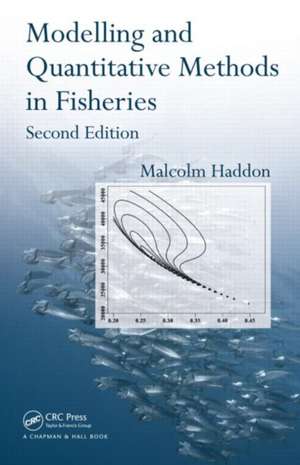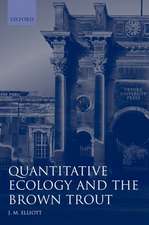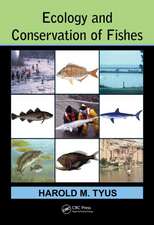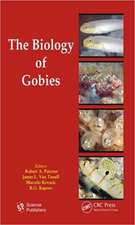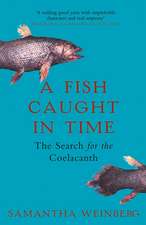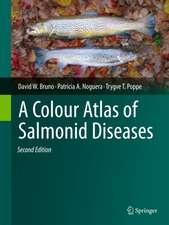Modelling and Quantitative Methods in Fisheries
Autor Malcolm Haddonen Limba Engleză Hardback – 11 mar 2011
In this second edition, the author has revised all chapters and improved a number of the examples. This edition also includes two entirely new chapters:
- Characterization of Uncertainty covers asymptotic errors and likelihood profiles and develops a generalized Gibbs sampler to run a Markov chain Monte Carlo analysis that can be used to generate Bayesian posteriors
- Sized-Based Models implements a fully functional size-based stock assessment model using abalone as an example
Preț: 709.63 lei
Preț vechi: 834.87 lei
-15% Nou
Puncte Express: 1064
Preț estimativ în valută:
135.83€ • 147.59$ • 114.17£
135.83€ • 147.59$ • 114.17£
Carte tipărită la comandă
Livrare economică 21 aprilie-05 mai
Preluare comenzi: 021 569.72.76
Specificații
ISBN-13: 9781584885610
ISBN-10: 1584885610
Pagini: 465
Ilustrații: 140 black & white illustrations, 22 black & white tables
Dimensiuni: 156 x 234 x 30 mm
Greutate: 0.77 kg
Ediția:Revizuită
Editura: CRC Press
Colecția Chapman and Hall/CRC
ISBN-10: 1584885610
Pagini: 465
Ilustrații: 140 black & white illustrations, 22 black & white tables
Dimensiuni: 156 x 234 x 30 mm
Greutate: 0.77 kg
Ediția:Revizuită
Editura: CRC Press
Colecția Chapman and Hall/CRC
Public țintă
UndergraduateCuprins
Fisheries and Modelling. Simple Population Models. Model Parameter Estimation. Computer-Intensive Methods. Randomization Tests. Statistical Bootstrap Methods. Monte Carlo Modelling. Characterization of Uncertainty. Growth of Individuals. Stock Recruitment Relationships. Surplus Production Models. Age-Structured Models. Size-Based Models. Appendix. Bibliography. Index.
Notă biografică
Malcolm Haddon is a senior fisheries modeller for CSIRO in Hobart, Tasmania, Australia. Prior to joining CSIRO, Dr. Haddon was an associate professor at the University of Tasmania, head of fisheries at Australian Maritime College, a senior research fellow at the University of Sydney, editor of the New Zealand Journal of Marine and Freshwater Research, and a lecturer at Victoria University of Wellington. He has conducted stock assessments on Tasmanian rock lobster, giant crab, and abalone. Now at CSIRO, he continues to produce stock assessments of abalone but also for an array of Australian Commonwealth fisheries.
Recenzii
The text remains true to the author’s initial aim of providing an introduction to the analytical methods currently being used in quantitative biology and fisheries science. It is important to remember when reading this book that there are few texts that students can truly consult on fisheries science without a detailed understanding of stock assessment and fisheries management practices—this text continues to bridge that gap.
The material has been revised and improvements made to a number of the examples. Two concerns and reservations that I commented on in my previous review have been addressed by the inclusion of two new chapters—one on characterizing uncertainty covering asymptotic errors and likelihood profiles, and the other on size-based models using abalone as an example. The book is lavishly illustrated throughout with the use of Microsoft Excel workbooks which adds to the flexibility, availability and ease of use of the text. I recommend the text both as a course companion and for private study.
—Carl M. O’Brien, International Statistical Review, 2012
This update of Malcolm Haddon’s book is timely and appreciated. The authors breadth of interest and experience really comes through. Fisheries science, and much of ecological science, has become highly numerical. Modelling, statistics, and scientific programming are now sought-after skills. This book doesn’t just tell you about these, but gives you the tools, and even the R code to do it. I would expect everyone from graduate students through to professionals to gain useful knowledge from this book.
- Matt Dunn, NIWA
Praise for the First Edition:
The book is a good introduction to modeling for students and practitioners. The emphasis is on population models, with chapters on parameter estimation, randomization tests, resampling methods, Monte Carlo methods, stock-recruitment, and age-structures models. One helpful feature is the use of spreadsheet examples to illustrate the methods.
—Fisheries, 2002
The material has been revised and improvements made to a number of the examples. Two concerns and reservations that I commented on in my previous review have been addressed by the inclusion of two new chapters—one on characterizing uncertainty covering asymptotic errors and likelihood profiles, and the other on size-based models using abalone as an example. The book is lavishly illustrated throughout with the use of Microsoft Excel workbooks which adds to the flexibility, availability and ease of use of the text. I recommend the text both as a course companion and for private study.
—Carl M. O’Brien, International Statistical Review, 2012
This update of Malcolm Haddon’s book is timely and appreciated. The authors breadth of interest and experience really comes through. Fisheries science, and much of ecological science, has become highly numerical. Modelling, statistics, and scientific programming are now sought-after skills. This book doesn’t just tell you about these, but gives you the tools, and even the R code to do it. I would expect everyone from graduate students through to professionals to gain useful knowledge from this book.
- Matt Dunn, NIWA
Praise for the First Edition:
The book is a good introduction to modeling for students and practitioners. The emphasis is on population models, with chapters on parameter estimation, randomization tests, resampling methods, Monte Carlo methods, stock-recruitment, and age-structures models. One helpful feature is the use of spreadsheet examples to illustrate the methods.
—Fisheries, 2002
Descriere
With numerous real-world examples, this text provides an introduction to the analytical methods used by fisheries’ scientists and ecologists. The author presents full, step-by-step derivations of equations as much as possible to enable a thorough understanding of the models and methods. This edition incorporates two new chapters on characterizing uncertainty and size-based models. It includes many worked examples in Excel that help explain the analyses in detail and demonstrate how to perform the analyses. Excel workbooks are available for download at www.crcpress.com.
